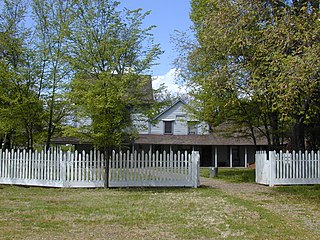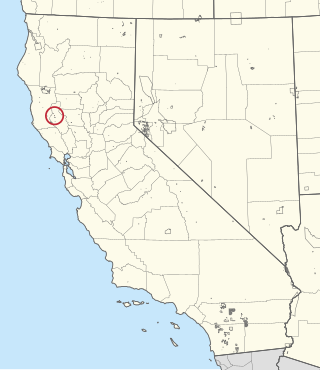Related Research Articles

The Pomo are a Native American people of California. Historical Pomo territory in Northern California was large, bordered by the Pacific Coast to the west, extending inland to Clear Lake, mainly between Cleone and Duncans Point. One small group, the Tceefoka, lived in the vicinity of present-day Stonyford, Colusa County, where they were separated from the majority of Pomo lands by Yuki and Wintuan speakers.

Anderson Marsh State Historic Park is a California State Historic Park and nature reserve preserving a tule marsh, archaeological sites of the Pomo people, and historic ranch structures. It is located in Lake County, California, United States. Anderson Marsh is located at the head of Cache Creek on the southeast corner of Clear Lake, the largest natural lake completely within the borders of California. The park is between the cities of Lower Lake and Clearlake on State Route 53, north of Calistoga in the wine country. The park is open year-round.

The Pomoan, or Pomo, languages are a small family of seven languages indigenous to northern California spoken by the Pomo people, whose ancestors lived in the valley of the Russian River and the Clear Lake basin. Four languages are extinct, and all surviving languages except Kashaya have fewer than ten speakers.

Schoenoplectus acutus, called tule, common tule, hardstem tule, tule rush, hardstem bulrush, or viscid bulrush, is a giant species of sedge in the plant family Cyperaceae, native to freshwater marshes all over North America. The common name derives from the Nāhuatl word tōllin, and it was first applied by the early settlers from New Spain who recognized the marsh plants in the Central Valley of California as similar to those in the marshes around Mexico City.

Northern Pomo is a critically endangered Pomoan language, formerly spoken by the indigenous Pomo people in what is now called California. The speakers of Northern Pomo were traditionally those who lived in the northern and largest area of the Pomoan territory. Other communities near to the Pomo were the Coast Yuki, the Huchnom, and the Athabascan. Ukiah High School first began offering Northern Pomo in the Fall 2020.
The indigenous religion of the Pomo people, Native Americans from Northwestern California, centered on belief in the powerful entities of the 'Kunula', a Coyote, and 'Guksu', a spirit healer from the south.

Kuksu was a religion in Northern California practiced by members within several Indigenous peoples of California before and during contact with the arriving European settlers. The religious belief system was held by several tribes in Central California and Northern California, from the Sacramento Valley west to the Pacific Ocean.

Southern Pomo is one of seven mutually unintelligible Pomoan languages which were spoken by the Pomo people in Northern California along the Russian River and Clear Lake. The Pomo languages have been grouped together with other so-called Hokan languages. Southern Pomo is unique among the Pomo languages in preserving, perhaps, the greatest number of syllables inherited from Proto-Pomo.
The Elem Indian Colony of Pomo Indians of the Sulphur Bank Rancheria are a federally recognized Native American tribe of Pomo people in California.
The Bloody Island Massacre was a mass killing of indigenous Californians by the U.S. Military that occurred on what was then an island in Clear Lake, California, on May 15, 1850. It is part of the wider California genocide.

The Big Valley Band of Pomo Indians of the Big Valley Rancheria is a federally recognized tribe of Pomo and Pit River Indians, with a reservation located in Lake County, California, near the town of Finley. They conduct tribal business from Lakeport, California.

The Habematolel Pomo of Upper Lake is a federally recognized tribe of Pomo Indians in Lake County, California. The tribe's reservation, the Upper Lake Rancheria, is 119 acres (0.48 km2) large and located near the town of Upper Lake in northwestern California.
Koi was the more southerly of the two main Pomo villages in the southeastern section of Clear Lake in Lake County, California, United States. Both it and the other triblet center, Elem, were located on islands near the shore and controlled territory on the mainland. It was located on Lower Lake Island, also called Indian Island.
Bokea is a former Pomo settlement in Mendocino County, California, one of a number of Pomo settlements catalogued by Stephen Powers. It was located in Rancheria Valley; its precise location is unknown.
Masut was a former Pomo settlement in Mendocino County, California, It was located 3 miles (4.8 km) northwest of Calpella. The same name was also given to a band of the Pomo people associated with the settlement.
Moiya is a former Pomo settlement in Mendocino County, California. It was located near Hopland; its precise location is unknown.

Pomo is an archaic place name in Mendocino County, California. It was located 1.25 miles (2 km) southeast of Potter Valley, at an elevation of 942 feet.
Ubakhea is a former Pomo settlement in Mendocino County, California, and a division of the Pomo people named for the settlement, recorded by George Gibbs in 1851. It was located in southern Mendocino County, near Sanel; its precise location is unknown.

Central Pomo is an extinct Pomoan language spoken in Northern California. Pre-contact speakers of all the Pomoan languages have been estimated at 8,000 all together. This estimation was from the American anthropologist Alfred Kroeber.

Kelsey Creek is a watercourse in Lake County, California, United States, that feeds Clear Lake from the south. Originally forest-covered, the watershed has been converted in the lower parts to farmland and for urban use. Higher up, the forests have been cleared, regrown, and cleared again. The northern part of the creek flows through a geothermal field that feeds power plants and hot springs. The wooded Cobb area in the higher part of the watershed was once home to resorts as early as the 1850s.
